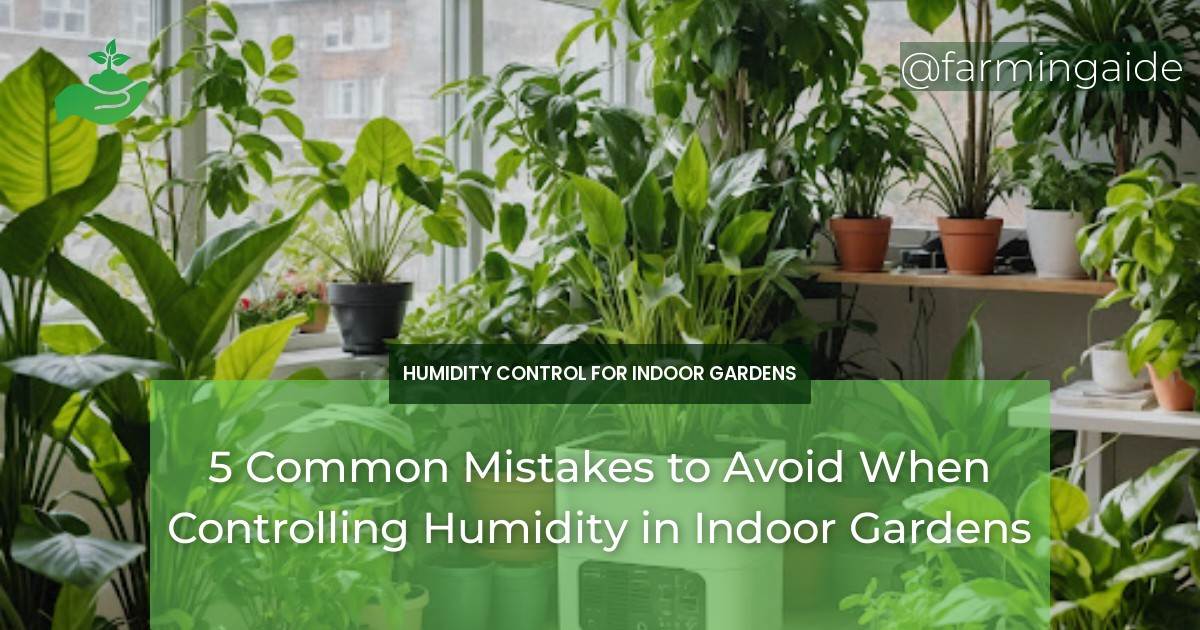When it comes to indoor gardening, many enthusiasts neglect one crucial aspect: humidity control. Maintaining the ideal humidity levels is essential for the health and well-being of your plants. However, it’s easy to make mistakes that can harm your plants and hinder their growth. In this article, we’ll explore the 5 common mistakes to avoid when controlling humidity in indoor gardens, providing you with the knowledge to create a thriving environment for your plants.
Key Takeaways
- Avoid overwatering plants, which can lead to excessive humidity and root rot.
- Ensure adequate ventilation to prevent stagnant air and maintain optimal humidity levels.
- Choose the right humidifier for your garden and maintain it regularly.
- Consider plant placement and grouping to optimize humidity levels.
- Regularly monitor humidity levels to adjust and maintain the ideal environment.
Understanding Humidity in Indoor Gardens
Humidity plays a vital role in indoor gardening, as it directly affects the health and growth of your plants. Most plants thrive in a humid environment, typically between 40-60% relative humidity. However, excessive humidity can lead to root rot, fungal diseases, and pest infestations.
To maintain the ideal humidity levels, it’s essential to understand the importance of humidity for indoor plants and the ideal humidity levels for different plants.
Importance of Humidity for Indoor Plants
Humidity affects the rate of transpiration, photosynthesis, and growth in plants. When the air is too dry, plants lose more water than they can absorb, leading to stress and reduced growth. On the other hand, high humidity can prevent water loss, promoting healthy growth and development.
Some plants, such as ferns and peace lilies, thrive in high-humidity environments, while others, like cacti and succulents, prefer drier conditions.
Ideal Humidity Levels for Different Plants
| Plant Type | Ideal Humidity Level |
|---|---|
| Tropical Plants (e.g., Ferns, Peace Lilies) | 50-70% |
| Succulents and Cacti | 40-50% |
| Herbs and Vegetables | 50-60% |
Mistake 1: Overwatering Plants
Overwatering is a common mistake that can lead to excessive humidity, root rot, and plant death. When the soil is consistently waterlogged, it prevents roots from breathing, causing the plant to suffocate.
Effects of Overwatering on Humidity:
- Excessive humidity, promoting fungal diseases and pest infestations.
- Reduced oxygen availability, hindering plant growth.
ALSO READ
Proper Watering Techniques
To avoid overwatering, it’s essential to monitor the soil moisture and adjust your watering schedule accordingly. Check the soil daily, and water only when the top inch of soil feels dry to the touch. Avoid getting water on the leaves to prevent fungal diseases.
Implement a drainage system to prevent waterlogged soil, and consider using a moisture meter to accurately measure soil moisture levels.
Mistake 2: Inadequate Ventilation
Inadequate ventilation is a common mistake that can lead to stagnant air, promoting fungal diseases and pest infestations. Proper air circulation helps maintain optimal humidity levels, preventing the buildup of condensation and moisture.
Role of Air Circulation in Humidity Control:
- Removes excess moisture, preventing condensation and fungal growth.
- Regulates temperature, preventing extreme fluctuations.
Tips for Improving Ventilation
Ensure good air circulation by:
- Placing plants at least 6-8 inches away from any walls or obstacles.
- Using fans to circulate the air, especially in small, enclosed spaces.
- Installing vents or windows to allow for natural air exchange.
Mistake 3: Using Inefficient Humidifiers
Using the wrong humidifier or neglecting maintenance can lead to inefficient humidity control, causing more harm than good.
Choosing the Right Humidifier for Your Garden:
- Consider the size of your garden and the humidifier’s capacity.
- Opt for a humidifier with adjustable settings and a built-in humidistat.
ALSO READ
Maintenance of Humidifiers
Regularly clean and descale your humidifier to prevent bacterial growth and mineral buildup. Replace the filter and wick as recommended by the manufacturer to ensure optimal performance.
Monitor the humidifier’s performance, adjusting the settings as needed to maintain the ideal humidity levels.
Mistake 4: Ignoring Plant Placement
Plant placement and grouping can significantly impact humidity levels in your indoor garden. By strategically placing plants, you can create microclimates that optimize humidity levels.
How Plant Placement Affects Humidity:
- Grouping plants together creates a microclimate with higher humidity.
- Placing plants near heating or cooling vents affects humidity levels.
Optimal Plant Spacing and Grouping
Group plants with similar humidity requirements to create a beneficial microclimate. Maintain a minimum of 6-8 inches between plants to ensure good air circulation and prevent moisture buildup.
Consider the mature size of plants when grouping, ensuring enough space for growth and air circulation.
Mistake 5: Not Monitoring Humidity Levels Regularly
Failing to regularly monitor humidity levels can lead to neglecting the optimal environment for your plants. Regular monitoring allows you to adjust and maintain the ideal humidity levels.
Importance of Regular Monitoring:
- Ensures optimal humidity levels for plant growth and health.
- Prevents moisture-related issues, such as fungal diseases and pest infestations.
Tools for Measuring Indoor Humidity
Use a hygrometer to accurately measure the relative humidity in your indoor garden. Choose from digital or analog hygrometers, considering factors such as accuracy, range, and ease of use.
Monitor humidity levels regularly, adjusting your humidifier settings or ventilation as needed to maintain the ideal environment.
Conclusion: Mastering Humidity Control for Healthy Indoor Gardens
By avoiding these common mistakes, you can create a thriving indoor garden with optimal humidity levels. Remember to monitor humidity regularly, adjust your humidifier settings, and maintain good air circulation to ensure a healthy environment for your plants.
By mastering humidity control, you’ll be well on your way to growing vibrant, healthy plants that will thrive in your indoor garden.


